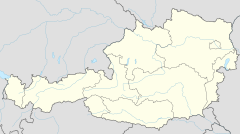
Back Клостернойбург (манастир) Bulgarian Klášter Klosterneuburg Czech Stift Klosterneuburg Danish Stift Klosterneuburg German Monaĥejo de Klosterneuburg Esperanto Abadía de Klosterneuburg Spanish Abbaye de Klosterneuburg French Biara Klosterneuburg ID Abbazia di Klosterneuburg Italian Canonia Claustroneoburgensis Latin
| Klosterneuburg Abbey | |
|---|---|
 Klosterneuburg Abbey seen from south | |
| Religion | |
| Affiliation | Catholic |
| Ecclesiastical or organizational status | Monastery |
| Year consecrated | 1136 |
| Status | Active |
| Location | |
| Location | Klosterneuburg, Austria |
| State | Lower Austria |
| Geographic coordinates | 48°18′26″N 16°19′33″E / 48.30722°N 16.32583°E |
| Architecture | |
| Type | Monastery |
| Style | Gothic, Baroque |
| Founder | Saint Leopold III |
| Groundbreaking | 1114 |
| Spire(s) | 2 |
| Website | |
| www | |
Klosterneuburg Abbey or Monastery (German: Stift Klosterneuburg) is a twelfth-century Augustinian monastery of the Catholic Church located in the town of Klosterneuburg in Lower Austria. Overlooking the Danube, just north of the Vienna city limits at the Leopoldsberg, the monastery was founded in 1114 by Saint Leopold III of Babenberg, the patron saint of Austria, and his second wife Agnes of Germany.[1] [2]
The abbey church, dedicated the Nativity of Mary (Maria Geburt), was consecrated in 1136 and remodeled in the Baroque style in the seventeenth century. The impressive monastery complex was mostly constructed between 1730 and 1834. Its foundations, including a castle tower and a Gothic chapel, date back to the twelfth century. Other older buildings still extant within the complex include the chapel of 1318 with Saint Leopold's tomb. From 1634 on, the Habsburg rulers had the facilities rebuilt in the Baroque style, continued by the architects Jakob Prandtauer and Donato Felice d'Allio. The plans to embellish the monastery on the scale of an Austrian Escorial were later resumed by the Neoclassical architect Joseph Kornhäusel, though only small parts were actually carried out. In 1879, the abbey church and monastery were restored according to plans by Friedrich von Schmidt, and the neo-Gothic twin steeples were erected.[1]
Klosterneuburg Monastery contains the Verduner Altar, made in 1181 by Nicholas of Verdun. Its three parts comprise 45 gilded copper plates modeled on Byzantine paragons, similar to the Shrine of the Three Kings at Cologne Cathedral.[1] The monastery also contains a museum with a collection of Gothic and Baroque sculptures and a gallery of paintings, including fifteen-panel paintings by Rueland Frueauf from 1505, four Passion paintings from the backside of the Verduner Altar from 1331, and the Babenberg genealogical tree.[3]
- ^ a b c "Klosterneuburg". Encyclopedia of Austria. Retrieved 18 January 2013.
- ^ "Stift Klosterneuburg: 900 Years of History". Augustinian Canons. Retrieved 15 February 2013.
- ^ Rennhofer 1999, p. 36.
